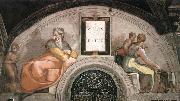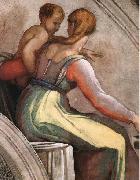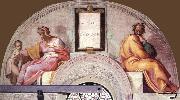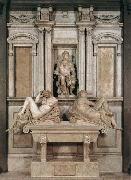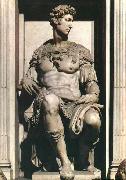Michelangelo Buonarroti El petróleo que Pinta la ReproducciónAll Michelangelo Buonarroti Oil Paintingsb Caprese 1475 d Rome 1564 |
|||

|
|||
|
|
|||
|
||||||||
| Michelangelo Buonarroti b Caprese 1475 d Rome 1564 |
||||||||
|
|
||||||||
| Pintura identificación:: 62937 Achim Eliud 1511-12 Fresco, 215 x 430 cm Cappella Sistina, Vatican "Zadok begat Achim. Achim begat Eliud. Eliud begat Eliazar." (Matthew 1:14-15) This is the first lunette on the south wall. The identity of the figures is not certain, and it is not possible to establish which of the two, Achim or Eliud, is the old man with a child next to him on the left, and which the child held by his mother on the right. The elaborate pose of the old man is very carefully constructed with vigorous twisting of the limbs. The sculptural effect of the figure is largely due to the prominence of the knees and the crossed arms, with the right elbow projecting notably and the hands folded in toward the body. This effect is heightened by the magnificent arrangement of the drapery, especially on the left knee and over the edge of the stone seat. The meditative attitude of the old man is counterbalanced on the other side of the lunette by the fascinating spontaneity of the woman's gestures. Turning toward her child, she stretches out her arm to take some food from a plate placed on a stool in the foreground. Artist: MICHELANGELO Buonarroti Painting Title: Achim - Eliud , 1501-1550 Painting Style: Italian , , religious |
||||||||
|
|
||||||||
| Pintura identificación:: 62938 Achim Eliud 1511-12 Fresco Cappella Sistina, Vatican Turning toward her child, the young woman stretches out her arm to take some food from a plate placed on a stool in the foreground. Artist: MICHELANGELO Buonarroti Painting Title: Achim - Eliud (detail) , 1501-1550 Painting Style: Italian , , religious |
||||||||
|
|
||||||||
| Pintura identificación:: 62939 Azor Zadok 1511-12 Fresco Cappella Sistina, Vatican "Eliakim begat Azor. Azor begat Zadok. Zadok begat Achim." (Matthew 1:13-14) This is the first lunette on the north wall. The absence of information regarding the figures represented has thwarted any attempt to identify them. On the left a seated woman is shown indicating something outside the lunette to a boy (or a girl) who seems to be engrossed in writing or drawing and turns somewhat hesitantly. The woman's pose, with its great naturalness and self-possession, is a variation on the twisted head, shoulders, and legs of the other figures. On the other side of the lunette, seen sideways on, but with his head turned toward the viewer, sits a solitary mature man, his face furrowed by deep lines. Tightly wrapped in his yellow ochre mantle, from which only his head and an arm emerge, he appears to be prey to distressing thoughts. The body, modelled concisely with great plastic power by the interplay of light and shade, and the pattern of the folds of the mantle, stands out clearly against the background. The number of figures present in this lunette is half that of the first lunettes painted by Michelangelo. This sense of isolation intensifies the expressive power of the figure of the pensive man, which some interpreted as being an imaginary self-portrait of the artist. Artist: MICHELANGELO Buonarroti Painting Title: Azor - Zadok , 1501-1550 Painting Style: Italian , , religious |
||||||||
|
|
||||||||
| Pintura identificación:: 63011 Tomb of Giuliano de' Medici 1526-33 Marble, 630 x 420 cm Sagrestia Nuova, San Lorenzo, Florence Michelangelo received the commission for the Medici Chapel in 1520 from the Medici Pope Leo X (1513-23). The Pope wanted to combine the tombs of his younger brother Giuliano, Duke of Nemours, and his nephew Lorenzo, Duke of Urbino, with those of the "Magnifici", Lorenzo and his brother Giuliano, who had been murdered in 1478; their tombs were then in the Old Sacristy of San Lorenzo. The plans for the chapel which we still have, shows us that the Pope allowed Michelangelo a great freedom in his task. Not much of this vast plan was in fact carried out, yet it is enough to give us an idea of what Michelangelo's overall conception must have been. Each of the Dukes' tombs is divided into two areas, and the border is well marked by a projecting cornice. In the lower part are the sarcophagi with the mortal remains of the Dukes, on which lie Twilight and Dawn, Night and Day as the symbol of the vanity of things. Above this temporal area, the nobility of the figures of the Dukes and the subtlety of the richly decorated architecture which surrounds them represent a higher sphere: the abode of the free and redeemed spirit. Artist: MICHELANGELO Buonarroti Painting Title: Tomb of Giuliano de' Medici , 1501-1550 |
||||||||
|
|
||||||||
| Pintura identificación:: 63012 Tomb of Giuliano de' Medici 1526-33 Marble Sagrestia Nuova, San Lorenzo, Florence Artist: MICHELANGELO Buonarroti Painting Title: Tomb of Giuliano de' Medici (detail) , 1501-1550 |
||||||||
|
|
||||||||
| ARTISTA PREVIO PROXIMO ARTISTA | ||||||||
|
|
||||||||
|
Michelangelo Buonarroti b Caprese 1475 d Rome 1564 |
||||||||
|
|
||||||||
|
CONTACTE EEUU |





